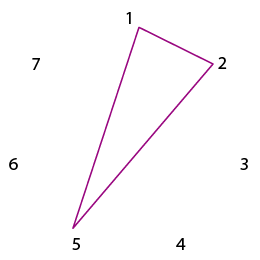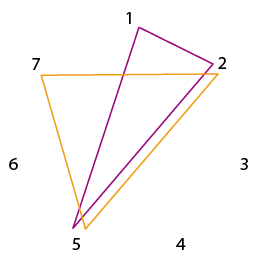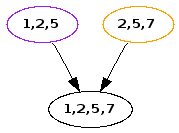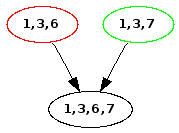Black & White 2: Battle of the Gods’ Skeleton Puzzle
The Dancing Skeletons silver scroll on Battle of the Gods’ Japanese land challenges you to get all seven skeleton dancing simultaneously. Click a gravestone to make skeletons start or stop dancing. Each gravestone affects a different set of skeletons:
| gravestone clicked | constraint | ||||||||
| 1 | 2 | 3 | 4 | 5 | 6 | 7 | |||
|---|---|---|---|---|---|---|---|---|---|
| skeletons affected |
1 | × | × | × | [1,3,6] | ||||
| 2 | × | × | × | [2,4,6] | |||||
| 3 | × | × | × | [1,3,7] | |||||
| 4 | × | × | × | [4,5,7] | |||||
| 5 | × | × | × | [1,2,5] | |||||
| 6 | × | × | × | × | [3,4,6,7] | ||||
| 7 | × | × | × | [2,5,7] | |||||
(Ignore the “constraint” column for the moment; we’ll need it later.)
Like Black & White’s totem or tree puzzles, we could solve this using simultaneous equations, but where’s the fun in that? Let’s use graph theory instead to bypass all the term juggling.
The order gravestones are clicked makes no difference, which means we’ll never need to click a gravestone twice. That simplifies our task.
From the table above, it’s obvious we have to click more than one gravestone to get all the skeletons dancing. So we’ll need at least a pair of gravestones in our solution.
Let’s begin by clicking the first pair of gravestones, (1,2). Reading down the columns, we find that skeletons #1, #2, #3, and #7 have been toggled once, so they’ll be dancing. Skeleton #5 has been toggled twice, so it won’t be. How do we fix this? Look at the constraint to the right of the fifth row: [1,2,5]. These are the gravestones that affect skeleton #5. We’ve seen clicking one of these gravestones makes skeleton #5 dance, but clicking two of them makes it stop. Clicking the remaining gravestone, 5, would get the skeleton dancing again. So we can click either one of these gravestones, or all three. We can model this constraint in a graph:

Now let’s look at another property of constraints. If our proposed solution shares exactly two numbers with a 3-digit constraint, then the third number in the constraint must be added to the proposed solution too. Here’s a sample graph:

Our proposed solution is currently (1,2,5). It shares the numbers 2 and 5 with the constraint [2,5,7]. This forces us to include the 7. This suggests a new kind of graph that shows how these constraints combine:

The new proposed solution (1,2,5,7) contains both 5 and 7. There’s a 3-digit constraint with these two numbers: [4,5,7]. So we have to add 4 to our proposed solution too. Continuing in the same manner, we get this:
![repeatedly combine constraints: [125], [257], [457], [246], [137], until the final node is 1234567](botg/skeleton.puzzle.4.png)
However, (1,2,3,4,5,6,7) isn’t a solution. It’s easy enough to check, but we can determine this directly from the table. Row #6 contains four numbers, not three. This means that skeleton #6 won’t be dancing if we click all the gravestones. So we can’t start with the pair (1,2), as constraint [1,2,5] forced us to a non-solution.
The obvious next pair to check is (1,3). The constraint [1,3,6] forces us to add 6: (1,3,6). There’s another 3-digit constraint containing 1 and 3: [1,3,7]. So we must add 7 to the proposed solution:

The only constraint that contains a pair from this proposed solution is [3,4,6,7]. This constraint is an oddball, since it has four numbers, not three. Our proposed solution can share one or three numbers with this constraint, but not two or four. But we’ve already got 3, 6, and 7, so it’s fine to leave 4 out. We’re not forced to add any more constraints to this proposed solution, so let’s check it. Hey, it works! Clicking gravestones (1,3,6,7) is a solution.
Last updated 27 December 2006
http://www.rdrop.com/~half/General/GameTips/botg.skeleton.puzzle.html
All contents ©2006 Mark L. Irons